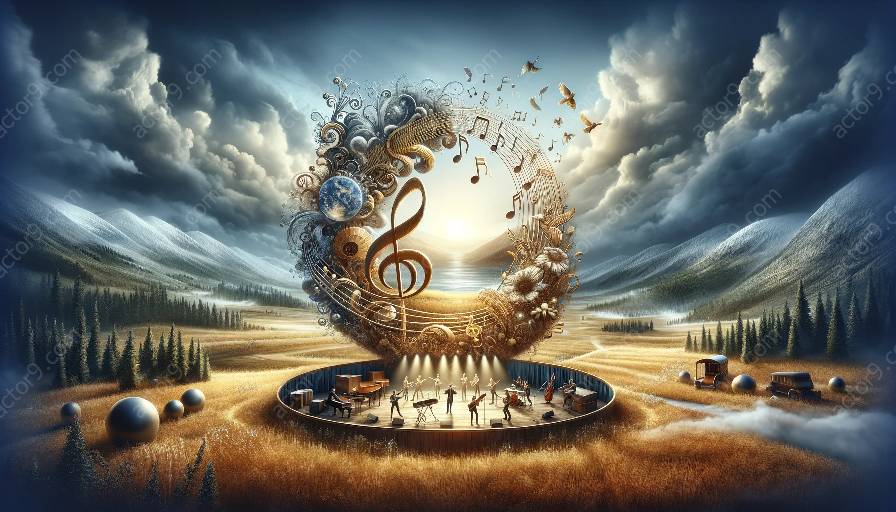Music plays a significant role in circus performances, serving as an essential element in creating atmosphere, enhancing the acts, and captivating the audience. The music used in circuses is influenced by various cultural elements, reflecting the diverse traditions, history, and artistic styles of different regions around the world. Understanding the cultural influences on circus music provides valuable insights into the rich tapestry of musical expression in the context of circus arts.
Role of Music in Circus Performances
The role of music in circus performances is multifaceted and dynamic. It serves as a powerful tool for creating emotional impact, amplifying excitement, and syncing with the visual spectacle of the acts. Beyond setting the tone and rhythm, circus music contributes to the storytelling, emphasizing key moments, and guiding the audience's attention. The harmonious integration of music and performances elevates the overall experience, making circus arts a truly immersive and captivating form of entertainment.
Cultural Influences on Circus Music
European Influence: The roots of modern circus music can be traced back to Europe, particularly the lively and dramatic compositions that complemented the circus acts. The European influence on circus music is characterized by grand orchestral arrangements, dramatic crescendos, and whimsical melodies that echo the historical extravaganzas of the circus.
Latin American Rhythms: In various circus performances, Latin American music and rhythms infuse the atmosphere with passion, energy, and vibrant beats. The lively dance rhythms, syncopated percussion, and melodic patterns of salsa, samba, and tango add an exuberant and playful dimension to circus acts, reflecting the cultural heritage of Latin America.
Asian Traditions: The cultural influences from Asia bring a diverse range of musical styles to circus performances. From traditional Chinese melodies to rhythmic Indian compositions, Asian music contributes an aura of mystique, elegance, and harmonious balance, enriching the sensory experience of circus arts with its distinct tonalities and techniques.
African Rhythms: African music and rhythms resonate through the circus, infusing performances with infectious beats, polyrhythmic textures, and dynamic vocal expressions. The diverse musical traditions of Africa, including the vibrant drumming, call-and-response chants, and expressive dance music, add a layer of raw energy and primal vitality to circus acts, reflecting the cultural wealth of the continent.
Circus Arts and Music Styles
The dynamism of circus arts is complemented by a wide spectrum of music styles that intertwine with the performances, creating an immersive and diverse sonic landscape. From classical orchestral compositions to modern electronic arrangements, circus music adapts to the evolving artistic sensibilities while maintaining a deep-rooted connection to tradition and cultural influences.
Classical Elegance:
The timeless allure of classical music finds its place in circus arts, providing a sense of grace, refinement, and grandeur. The elegant symphonic arrangements, majestic waltzes, and evocative operatic pieces elevate the aerial acts, acrobatics, and equestrian displays, adding a touch of sophistication and emotive depth to the performances.
Modern Fusion:
In contemporary circus arts, the fusion of modern music styles creates a vibrant and eclectic sonic backdrop. The fusion of electronic, rock, jazz, and world music elements brings a fresh and innovative dimension to circus performances, resonating with diverse audiences and reflecting the ever-changing cultural landscape.
Global Expressions:
The global nature of circus arts embraces a rich mosaic of music styles from around the world. Whether it's the exuberant carnival tunes of Brazil, the haunting melodies of Eastern Europe, or the rhythmic beats of Africa, circus music celebrates the cultural diversity and unique musical expressions that enrich the global community.
Conclusion
Understanding the cultural influences on circus music provides a deeper appreciation for the intricate connections between music, art, and human expression. The role of music in circus performances extends beyond mere accompaniment, embodying the traditions, innovations, and emotive essence of diverse cultures. By delving into the rich tapestry of music styles and cultural influences, the enchanting world of circus arts becomes a vibrant celebration of human creativity and the universal language of music.


































